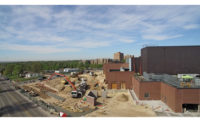A key component of the campus-wide carbon-reduction effort at the University of Colorado Boulder involves an extensive overhaul of the existing natural gas-fired cogeneration equipment in the powerhouse to produce both steam and electrical power.
The upgrade of the campus’ central utilities into a new state-of-the-art system included several strategies that have increased capacity and provide a high level of reliability and sustainability. In addition, the envelope for the system is enclosed in a beautiful new building, both inside and out.
In addition to the complex engineering design of the project, the architectural role on the CU Campus Utility System was unique because of the overall massing of the East District Energy Plant building and its key location at the edge of the campus.
The design team worked diligently to suppress the mass of the building as much as possible into the existing hillside to minimize the impact of the exterior envelope. With the large cooling towers located on the roof, designers also sought to hide them and reduce their visual impact.
Teaming Up
The CU utility system project team included Lutz, Daily & Brain LLC Consulting Engineers, The RMH Group, LOA Architecture, S.A. Miro Inc. and JE Dunn Construction. The team worked together on value analysis to maximize the scope within the budget.
Schematic design called for the new six-level East District Energy Plant (EDEP) to be built 100 ft tall and sunk into a bank nearly 40 ft deep. Using Bluebeam to demonstrate the value of raising the grade by 13 ft, eliminating a 10-ft elevation step within the building, combining levels and lowering the roof by 10 ft, the team concluded that value was gained not only in costs but also in aesthetics, massing and internal ease of use and building maintenance.
Close coordination with the mechanical engineer was important to provide not only an aesthetically pleasing and campus-compatible exterior but also a functional interior with ample clearance for complex mechanical equipment. Site design included large “pull-out” areas to allow for easier replacement of boilers.
In addition, because of the building’s close proximity to the Coors Event Center, both horizontal and vertical transitions were created between the two facilities. A mandatory egress route and pathway to an adjacent parking structure required construction of a series of stairs and landings to accommodate a change of 100 vertical ft.
Campus Design Standards
The architectural design scope included maintaining the campus design elements and standards. CU Boulder is widely recognized as having one of the most beautiful and thematically consistent campuses in the nation.
“Architectural historians categorize the CU style as Tuscan Vernacular but many lovingly refer to it as the ‘Klauder style,’ a homage to Charles Z. Klauder, who designed 15 buildings at the University of Colorado,” says Timothy Habben, project principal and owner of LOA Architecture, the architecture firm of record.
Even as an energy plant, the design of the EDEP building was required to follow campus architectural standards for building materials established for academic buildings, not for energy plants. The exterior façade is a combination of board-formed, cast-in-place concrete and sandstone, all of which are found on campus. The roof features the straight-barrel mission tile, also common on campus.
CU is pursuing LEED-Gold certification for the new EDEP building. The entire project was awarded ENR Mountain State’s 2015 Best Project honors in the Energy/Industrial category.
The completed, multi-phased project now provides safe, reliable campus utility needs— chilled water, steam and electricity—while reducing carbon emissions, conserving natural resources, minimizing impacts and maintaining the integrity of campus design.



Post a comment to this article
Report Abusive Comment